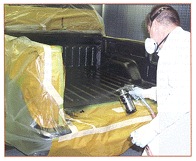Spraying bedliners is a way to boost your bottom line — and is strictly
a customer-pay upgrade (read: no insurer involvement).

It’s not easy owning a collision repair shop these days. Business is down, costs are up (and continue going up), customers are pickier than ever, insurers are cheaper than ever …
Bet you could use some extra income.
What should you do? Maybe what a lot of other shops owners have done: Get into bed — bedliners, that is.
Currently, there are 59 million light trucks and SUVs on the nation’s highways, and according to research by Frost & Sullivan, the North American light truck accessories market is expected to generate $1.89 billion by 2007.
While growth in the accessories portion of the aftermarket industry has been relatively slow (2 to 3%), the “performance accessories” portion, which includes bedliners, has grown 8%. More specifically, the bedliner market has grown steadily at 3-4%, according to Jasmine Sachdeva, research manager/aftermarket for Frost & Sullivan.
According to the Specialty Equipment Market Association’s (SEMA’s) 2005 Trends and Forecasts Report, 21% of new pickup truck owners plan to modify their vehicles with a sprayed-on bedliner, and 12% plan to buy a drop-in bedliner. This same study shows that 37.5% of new vehicle owners accessorize their rides within the first three weeks after buying and that 84.2% of consumers purchase vehicle accessories within six months after buying.
Obviously, there’s a market for bedliners, but that’s not even the biggest advantage cited by many shop owners doing bedliner work. The biggest advantage?
No insurer involvement, of course.
Interested?
Let’s take a closer look …
Location, Location, Location
Naturally, there are regional factors to consider when contemplating a bedliner business. For instance, if you’re located near an ocean, there’s going to be more of a demand for sprayed-on liners versus drop-in liners.
“We’re in an area that’s right on the coast so we have a lot of fishermen and lobstermen in the area, and we know the damage that can be done to a bed that has a drop-in liner because of the salt water getting underneath it,” says Rick Starbard, president of Rick’s Auto Collision in Revere, Mass. Starbard added a bedliner business to his shop about three years ago. “Part of the market demand here is geographic for that reason, but the demand for bedliners is nationwide.”
You also have to consider what’s going on bedliner-wise in your local market. Is there a business in your area that does truck bed accessories exclusively? Are any other collision repair shops spraying bedliners in addition to doing collision repair work?
You need to assess how saturated — or unsaturated — your local market is.
Getting Started
After assessing your local market and determining that it’s not already saturated, you need to decide if you want a bedliner franchise or if you’d prefer to become a dealer.
With a franchise, you’re going to pay the company a percentage of your gross sales and may have to sign a contract for a specific time frame. But the benefits can include training, advertising expertise, startup assistance and bulk purchasing.
If you become a dealership for a manufacturer, there’s usually a contract between you and the bedliner company and you have a protected territory. Typically, you agree to purchase a certain amount of chemicals from the parent company.
You can decide to add a dealership or franchise to your existing collision repair business, or you can focus on a whole new market, like truck bed accessories. That’s what one-time collision shop employee Jason Moore did. He owns Creative Coatingz in Macon, Ga., and he’s had reasonable success with his business in the six years since he started it.
“I bought a dealership because with a franchise, you’re paying franchise dues and there are certain regulations and stipulations,” he says. “They set parameters that you have to follow. With a dealership they say, ‘You buy the machine and the materials from us.’
“It cost me close to $20,000 to get started and that included the machine to spray with and enough material to do a certain amount of trucks, training and some point-of-purchase display stuff. When I got started, I already had a booth, and we’ve since built another booth designed to get the airflow that you need.”
Depending on the system you choose, you can spend anywhere from $5,000 to $85,000 to get started in the bedliner business. The key is to research the system. Different packages include different things. Know what you’re getting — and not getting — for your money.
“It cost me around $50,000,” says Starbard. “That includes buying the equipment and also the cost to adapt the building to their specifications, signage and everything involved in getting started. Somebody who doesn’t have a building would have to spend significantly more.”
So what’s it take to get started? It all depends on the bedliner system you choose. For the most part, however, it’s going to take what you already have. Your people already know how to spray. They also know how to prep. These are the two most important jobs in spraying a bedliner.
Sure, you’re going from paint to polyurethane, but anyone with paint experience can make a smooth transition, say the bedliner manufacturers.
As for setup, some say a body shop has nearly everything needed to spray truck bedliners — a spray gun, a compressor, a spraybooth and people who are used to doing prep work.
Ultimately, however, what equipment you need and how much space you need depends on which bedliner system you choose. For example, you can’t always use your spraybooth to spray bedliners. In some cases, you’ll need a special machine (part of the package when you sign on) and a special spray area with adequate exhaust in your shop for spraying bedliners.
Some systems also require a preparation area for sanding and masking. This is usually separate from the spray application area. The spray area requires a minimum of about 350 square feet (14 feet by 25 feet) to spray a full-size truck. Extra space will allow you to spray larger vehicles like motor homes, trailers, dump trucks, street sweepers and other commercial vehicles.
Show Me the Money
The average cost of a bed-liner job depends on the area of the country you’re in and the size of the truck bed, but it typically runs around $400. A bedliner job will include miscellaneous costs like sandpaper, masking tape, paper, rags and respirators, along with the cost of labor and bedliner material. The length of time it takes to complete the job also affects gross profit.
“One bedliner job usually takes 1.5 to two hours,” says Moore. “I have one guy who sands, I have one guy who sprays and tapes and two other guys who help. In a typical day, if we don’t do 4-5 liners, we’ve had a slow day. Typically. you’re going to be in the $200-225 range in cost, depending on the truck, and the average job costs $300-400.”
In some markets, you can make up to 50% gross profit per job, with many areas of the country averaging between 20 and 30%.
“Our gross profit per vehicle is between $200-$240. That isn’t bad,” says Starbard. “The part of the building that we do it in was only used before to clean cars, and that was a free service.
“We haven’t had people come in for body work who walk out with a bedliner, but we have had people who came in for a bedliner and a month or two later had an accident and turned into a collision customer.”
As with most services, you also have the opportunity to upsell the customer, in this case, by offering custom colors and glow-in-the-dark liners, which can increase the price (and your profits) significantly.
Should You or Shouldn’t You?
“We expect that the spray-on bedliner market won’t go away, but I believe there’s going to be a change because there’s been a slowdown of truck sales,” says Frost & Sullivan’s Sachdeva. “Also, the price of chemicals is going up, so this cost has to be passed from the chemical houses to the masters to the franchisees to the final end user — the truck owner. So we expect prices to increase. However we expect this market will continue to experience strong growth through 2007.”
Would bedliners be the edge you need?
Maybe. Maybe not. The fact is, we can’t give you all the answers in one article. It’s up to you to study your market, investigate the specifics of the systems out there and determine if the bedliner business would — or wouldn’t be — beneficial for you.
In Starbard’s case, he says that adding bedliners to complement his collision repair business has been beneficial.
“One of the things I like about offering bedliners is that it’s something that allows you to participate in the free market system like the rest of America. When customers come in and you give them a price, they either take it or they don’t. You don’t have an insurance company saying, ‘Well, you know, I really don’t think so. I think you should do it for $50 less.’ ”
Writer Bob Bissler is managing editor of BodyShop Business.
|
Bedliner Manufacturers Ameraguard Sprayed Bedliners www.ameraguard.com |













